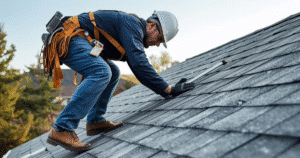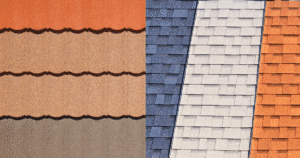• Identify critical signs of needing a roof replacement, such as leaks and missing shingles
• Learn the steps to choose materials and find a licensed contractor for the job
• Understand the complete process of replacing a roof, from estimate to final cleanup
Recognizing the Red Flags of Roof Damage
Knowing when it’s time to consider a new roof is essential in maintaining the integrity of your home. Frequent inspections can reveal early warning signs of deterioration, such as cracked, curling, or missing shingles that suggest your roof is approaching the end of its lifespan. Interior indicators include persistent leak spots on ceilings or walls and unexplained mold or odors, particularly in the attic. Paying attention to these signs allows you to act before minor issues escalate into major structural concerns.
If your roof has weathered severe storms or substantial climatic changes, it may show more significant wear and tear. Granule loss on asphalt shingles, for example, is a subtle yet telling sign of an aging roof, especially if your gutters are laden with granules after rainfall. Dark streaks or patches can also signal algae growth, common in hot and humid summer months, which may not require a full replacement but calls for a professional evaluation. It’s vital to assess the condition of your roof, considering both age and appearance to make an informed decision about replacement.
Rarely will a roof need immediate replacement without prior symptoms; thus, regular visual inspections are a homeowner’s first defense. It is crucial to note that neglect can lead to complicated damages, including compromised structural integrity, which may affect the entirety of your home. While roofing materials are designed for durability, factors like improper installation, poor ventilation, or the presence of moss and lichen can accelerate their decline. Acknowledging these concerns early paves the way for a planned, cost-effective roof replacement rather than an urgent and often more expensive fix.
Selecting Roofing Materials and a Trusted Contractor
Step 1: Evaluate Your Roofing Needs
Consider the age and condition of your current roof to determine if a full replacement is necessary. Inspect for signs of significant wear, leaks, or structural damage.
Step 2: Choose the Right Material
Research and select roofing materials that suit your home’s style, climate conditions, and budget, such as asphalt shingles, metal roofing, or tiles.
Step 3: Find a Qualified Roofing Contractor
Seek out reputable roofing professionals in your area with experience and positive reviews. Check their credentials and ensure they are licensed and insured.
Navigating the Roof Replacement Estimate
Once you’ve decided that a roof upgrade is imminent, it’s time to dive into the nitty-gritty of cost. A detailed estimate from a reliable contractor will encompass not just the price of materials and labor but also account for any potential contingencies that may arise. A quote should outline the timeframe for the project, considering factors like the scope of work, size of the roof, and the team’s availability. This transparency is vital to avoid any surprise costs and ensures that both parties have a clear understanding of the project’s scope.
Understanding the estimate is crucial, as it lays the groundwork for what you can expect during the roof replacement. Ensure that warranties are included within the quote to safeguard your investment long after the job is done. Pay attention to the details regarding the disposal of old materials, as proper disposal is essential for environmental conservation. Don’t hesitate to reach out to your contractor, such as the professionals at Ecobuild Roofing, to clarify any aspects of the estimate or contract that you might not fully understand.
The Replacement Process Unveiled
Step 4: Get a Detailed Estimate
Request a comprehensive quote from the contractor that covers all aspects of the roof replacement process, including materials, labor, and time frame.
Step 5: Prepare for Replacement
Prior to the start of work, prepare your property by removing any fragile items, ensuring access, and discussing property protection measures with the contractor.
Step 1: Evaluate Your Roofing Needs
Consider the age and condition of your current roof to determine if a full replacement is necessary. Inspect for signs of significant wear, leaks, or structural damage.
Step 2: Choose the Right Material
Research and select roofing materials that suit your home’s style, climate conditions, and budget, such as asphalt shingles, metal roofing, or tiles.
Step 3: Find a Qualified Roofing Contractor
Seek out reputable roofing professionals in your area with experience and positive reviews. Check their credentials and ensure they are licensed and insured.
Step 4: Get a Detailed Estimate
Request a comprehensive quote from the contractor that covers all aspects of the roof replacement process, including materials, labor, and time frame.
Step 5: Prepare for Replacement
Prior to the start of work, prepare your property by removing any fragile items, ensuring access, and discussing property protection measures with the contractor.
Step 6: Roof Removal
The contractor will remove the old roof materials safely and efficiently, preparing the roof deck for the new installation.
Step 7: Install New Roofing Material
The chosen materials will be installed following manufacturer’s guidelines and building codes, with attention to weatherproofing and insulation.
Step 8: Final Inspection and Cleanup
After installation, the contractor should perform a thorough inspection, make any necessary adjustments, and clean up the site to ensure your new roof is ready for the season.
Steering Clear of Roof Replacement Pitfalls
Embarking on a roof replacement project can be a challenging endeavor, particularly for those tempted by the notion of DIY. While this approach may seem cost-effective, it often leads to mistakes that compromise roof integrity and safety. Understanding common missteps in the roof replacement process is pivotal in avoiding unnecessary complications and ensuring a lasting and reliable roofing system.
- Ignoring Professional Inspection
Many homeowners underestimate the value of a professional evaluation. Skipping this step can mean missing underlying issues, leading to poor decision-making about whether a repair or full replacement is needed. Always start with a professional assessment to determine the exact roofing needs. - Selecting Materials Based Solely on Price
While budget is important, the cheapest materials may not provide the best value over time. Cheap materials can lead to early wear and require more frequent replacements. Consider lifecycle costs and select materials that offer a balanced combination of affordability and durability. - Overlooking Local Weather Patterns
Choosing roofing materials that are ill-suited for your local climate can cause premature failure. For example, metal roofing may be prone to denting in hail-prone areas, while asphalt shingles might not fare well in extremely hot climates. Pick materials that can withstand your area’s weather challenges. - DIY Installation Errors
A roof replacement requires precision and knowledge of local building codes. Without experience, DIYers can make installation errors, like improper shingle alignment or inadequate sealing, leading to leaks and damage. It’s generally best to trust this job to licensed and insured roofing professionals. - Not Preparing the Worksite Properly
Failure to clear the area or protect the property can result in damage to landscaping or outdoor features. Take the time to prepare your work site, ensuring that all areas are clear and valuables are protected from construction debris. - Insufficient Planning for Debris Disposal
Underestimating the amount of waste generated can be a blunder. Rent a dumpster or plan with your roofing contractor for debris removal. Proper disposal is crucial to keep your property clean and prevent environmental hazards. - Ignoring Safety Procedures
Roof work is hazardous, and skimping on safety can lead to accidents or injuries. Use appropriate safety gear, and follow all recommended precautions to protect yourself and others. - Disregarding the Importance of a Final Cleanup
Leaving nails, shingles, or other materials around the property is not only unsightly but also dangerous. Ensure a thorough post-job cleanup is part of the agreement with your roofing contractor.
Preparing for the Big Day
When the roof replacement day draws near, homeowners should take proactive steps to ensure a smooth transition. It’s advisable to clear the attic space and surrounding areas, securing or relocating valuables that could be affected by the construction. Additionally, providing easy access to your roof can significantly expedite the replacement process, allowing the team to work efficiently.
Another key aspect is open communication with your contractor about logistics and property protection. Discussing these elements upfront minimizes disruptions and protects your property from unintended damage. Factoring in these preparatory steps is an investment in the peace of mind that comes with knowing your home is in good hands.
After the Installation: Ensuring Quality and Cleanliness
The final steps post-installation are critical in the roof replacement journey. A thorough inspection by the contractor will confirm that the installation adheres to the highest standards. The clean-up that follows is just as important, ensuring that your property remains tidy and safe with all debris removed.
Step 6: Roof Removal
The contractor will remove the old roof materials safely and efficiently, preparing the roof deck for the new installation.
Step 7: Install New Roofing Material
The materials chosen will be installed following the manufacturer’s guidelines and local building codes, focusing on aspects critical to roofing such as weatherproofing and insulation.







